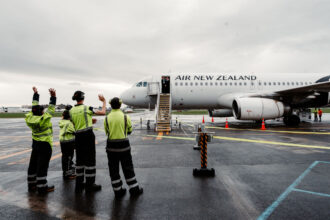Auckland Airport has officially opened its biggest airfield upgrade since it began operations in 1966 – a $465 million project that adds the equivalent of 23 rugby fields of new apron and taxiway space.
The new area provides parking for up to 11 jets, including five fully serviced stands with jet fuel and electricity connections, plus one unserviced stand. It also paves the way for the next stage of construction on the new domestic jet terminal.
Auckland Airport Chief Executive Carrie Hurihanganui called the project a milestone for the country’s main gateway.
“Right now, New Zealand’s international connectivity is still recovering to reach and surpass 2019 levels, but we are optimistic for the future with long-term growth on the horizon,” she said.
“Key international airline partners tell us they are preparing to take delivery of new aircraft over the coming years, including one with an order of around 150 planes. This growth presents an important opportunity for New Zealand, and AKL’s airfield investment means we will have the right infrastructure in place, at the right time, to support efficient operations while strengthening the country’s travel and trade connections.”
The new apron links directly to the airport’s developing cargo precinct via a newly built airside road.
“Cargo is an important, if sometimes less visible, part of international connectivity,” said Ms Hurihanganui. “While we are served by a strong freighter network, around 80% of New Zealand’s air cargo still travels in the belly of passenger aircraft. Much of it is high-value New Zealand produce – flowers, salmon, cherries – that must arrive in overseas markets in perfect condition.”
Auckland Airport currently handles over $26 billion of trade annually, a figure expected to grow to $41 billion by 2032.
Big build, big effort
The project involved more than a million cubic metres of soil being shifted and 67,400m³ of concrete being poured – enough to fill more than 25 Olympic swimming pools. Around 108,000 tonnes of old runway concrete was recycled and reused to build the foundations, avoiding nearly 4,000 truck trips.
Jason Dardis, Airfield Programme Director, said the pavement was designed to take the weight of some of the largest aircraft in the world.
“The airfield has a pavement build-up of about one metre with the top layer being half a metre of concrete. In some areas, where we were installing services and the 4.4km stormwater system that now runs under the airfield, we have excavated down to six metres,” he said.
“It’s been a huge team effort and a significant step in preparing the airport for the future.”
At its peak, up to 600 construction workers were on-site daily. Construction started in 2019, paused during the pandemic, and restarted in mid-2022.
Future ready
While the new stands do not currently connect to the terminal via airbridges, they are set up for future conversion when demand grows.
“As part of our master planning process, which is underway now, we anticipate a time when more contact stands will be needed,” said Ms Hurihanganui.
The expansion is part of Auckland Airport’s wider $3.9 billion terminal integration programme, which includes a new 240-metre domestic jet pier with 12 jet gates and an 80,000 m² domestic apron. The pier is expected to deliver 26% more seat capacity than the current domestic terminal once complete.














